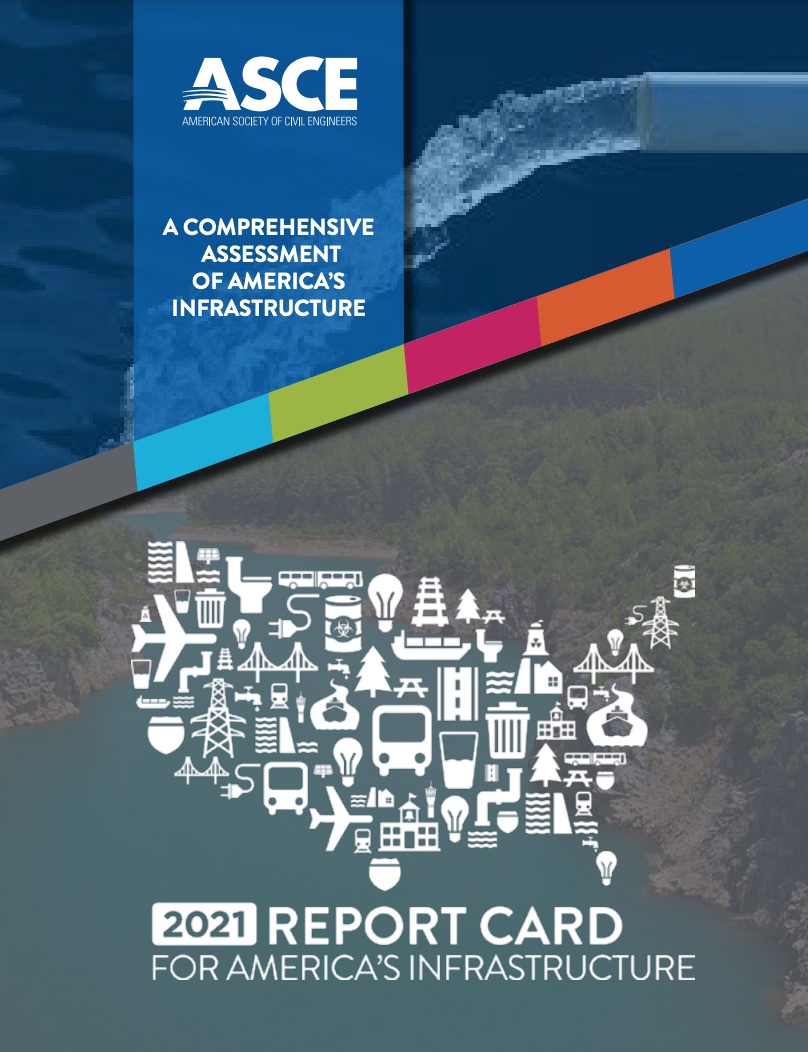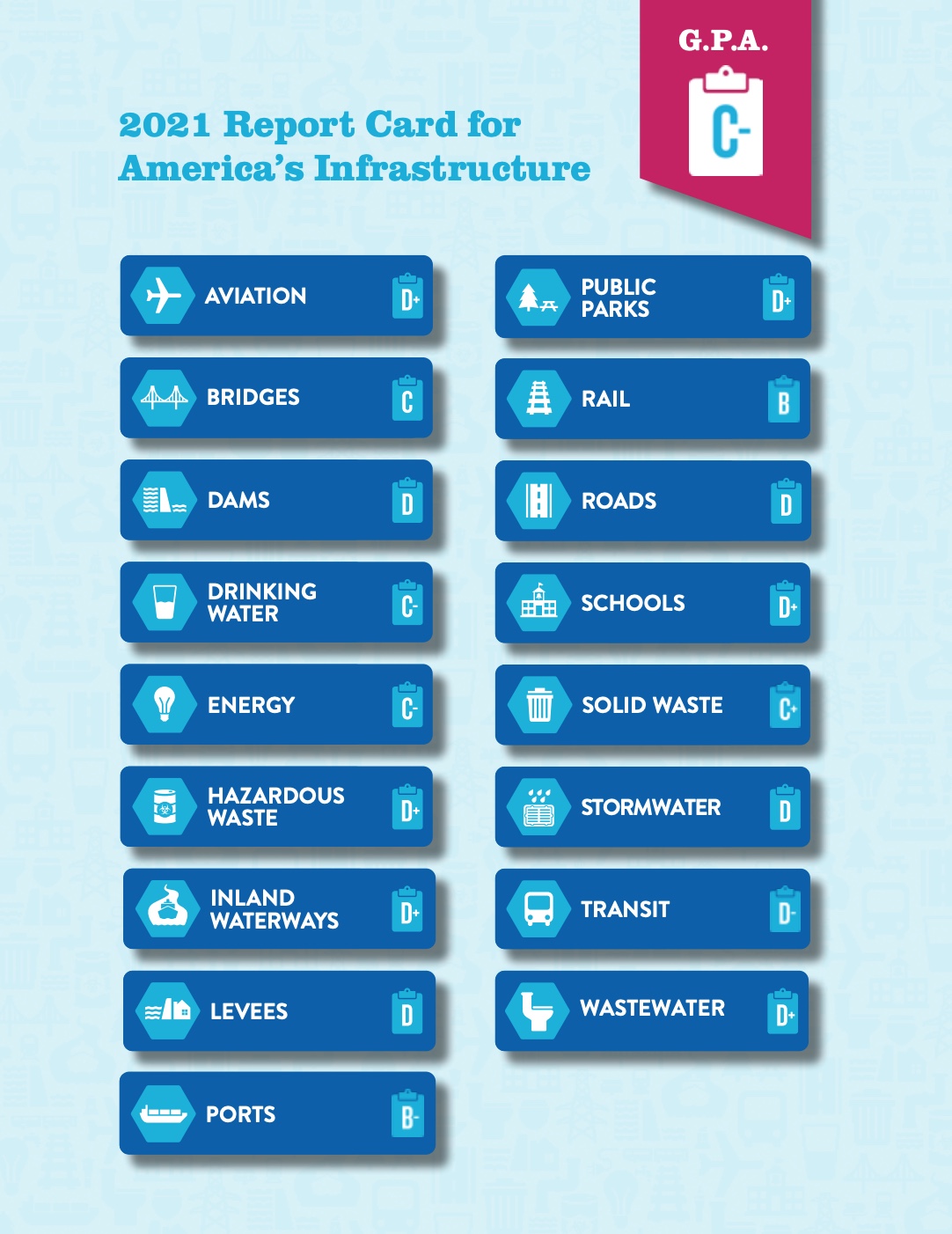AMERICAN SOCIETY OF CIVIL ENGINEERS (ASCE)
Introduction
 Infrastructure supports nearly every aspect of life. Our pipes deliver drinking water to homes and hospitals. Airports, railroads, and inland waterways transport goods from farms and manufacturing plants to store shelves. The roads that crisscross the country allow us to get to work and school safely, and the network of transmission and distribution lines keeps the lights on and our electronics charged. Dams enable consistent water supply in arid climates, and levees hold back floodwaters to protect rain-soaked communities.
Infrastructure supports nearly every aspect of life. Our pipes deliver drinking water to homes and hospitals. Airports, railroads, and inland waterways transport goods from farms and manufacturing plants to store shelves. The roads that crisscross the country allow us to get to work and school safely, and the network of transmission and distribution lines keeps the lights on and our electronics charged. Dams enable consistent water supply in arid climates, and levees hold back floodwaters to protect rain-soaked communities.
Since ASCE began issuing the Report Card in 1998, the grades have struggled to get out of the D’s. However, more recently, decision-makers at all levels of government have recognized the critical role our infrastructure plays in supporting our quality of life and economy. Voters and lawmakers alike have championed smart infrastructure policy and increased investment in our multimodal freight system, drinking water networks, and more. This down payment on our infrastructure bill has contributed to modest but meaningful improvements.
Key Findings
The 2021 Report Card for America’s Infrastructure reveals we’ve made some incremental progress toward restoring our nation’s infrastructure. For the first time in 20 years, our infrastructure is out of the D range.
 The 2021 grades range from a B in rail to a D- in transit. Five category grades — aviation, drinking water, energy, inland waterways, and ports — went up, while just one category — bridges — went down. And stormwater infrastructure received its first grade: a disappointing D. Overall, eleven category grades were stuck in the D range, a clear signal that our overdue bill on infrastructure is a long way from being paid off.
The 2021 grades range from a B in rail to a D- in transit. Five category grades — aviation, drinking water, energy, inland waterways, and ports — went up, while just one category — bridges — went down. And stormwater infrastructure received its first grade: a disappointing D. Overall, eleven category grades were stuck in the D range, a clear signal that our overdue bill on infrastructure is a long way from being paid off.
While we grade 17 categories individually, our infrastructure is a system of systems and more connected than ever before. As we look at the low grades and analyze the data behind them, there are three trends worth noting:
- Maintenance backlogs continue to be an issue, but asset management helps prioritize limited funding. Sectors like transit and wastewater have staggering maintenance deficits, but developing a clear picture of where the available funding is most needed improves overall system performance and public safety. The drinking water sector, for example, has embraced asset management and new technology to pinpoint leaks and target repairs.
- State and local governments have made progress. Increased federal investment or reform has also positively impacted certain categories. Thirty-seven states have raised their gas tax to fund critical transportation investments since 2010. Ninety-eight percent of local infrastructure ballot initiatives passed in November 2020. At least 25 major cities and states now have chief resilience officers. These improvements were made by elected officials from both sides of the aisle and with strong voter support. Meanwhile, categories like ports, drinking water, and inland waterways have been the beneficiaries of increased federal funding.
- There are still infrastructure sectors where data is scarce or unreliable. Sectors like school facilities, levees, and stormwater still suffer from a lack of robust condition information or inventory of assets. To target investments and allocate funding, routine, reliable data should be the standard.
The elected officials and members of the public who have improved infrastructure policy and supported additional funding are applauded. We’re seeing the benefits of this action in drinking water, inland waterways, and airports. The private sector has invested in the electric grid, freight rail, and more.
However, significant challenges lie ahead. Importantly, the COVID-19 pandemic’s impacts on infrastructure revenue streams threaten to derail the modest progress we’ve made over the past four years. In addition, many sectors and infrastructure owners are learning what it will take to make our communities climate resilient as we grapple with more severe weather. Meanwhile, many of our legacy transportation and water resource systems are still in the D range. These infrastructure networks suffer from chronic underinvestment and are in poor condition.
We’re headed in the right direction, but a lot of work remains.
Recommendations to Raise the Grade
To improve our quality of life and strengthen our international competitiveness, we need a strategic and holistic plan to renew, modernize, and invest in our infrastructure. This plan should make basic maintenance a centerpiece as we improve our legacy systems. Importantly, policymakers must understand we are only as strong as our weakest link — if our roadways become too rough to travel, if our bridges close to heavier traffic like ambulances, or if our levees protect a community at the expense of the one next door, the economy grinds to a halt. We all pay the price.
ASCE urges bold leadership and action, sustained investment, and a focus on resilience to raise the national infrastructure grade over the next four years, so that every American family, community, and business can thrive.
1) Leadership and action
Smart investment will only be possible with strong leadership, decisive action, and a clear vision for our nation’s infrastructure. Leaders from all levels of government, business, labor, and nonprofit organizations must come together to:
a. Incentivize asset management and encourage the creation and utilization of infrastructure data sets across classes.
b. Streamline the project permitting process across infrastructure sectors, while ensuring appropriate safeguards and protections are in place.
c. Ensure all investments are spent wisely, prioritizing projects with critical benefits to the economy, public safety, environment, and quality of life (e.g., sustainability).
d. Leverage proven and emerging tech to make use of limited available resources.
e. Consider life cycle costs when making project decisions. Life cycle cost analysis determines the cost of building, operating, and maintaining the infrastructure for its entire life span.
f. Support research and development of innovative materials, technologies, and processes to modernize and extend the life of infrastructure, expedite repairs or replacements, and promote cost savings. Innovation should include a component of integration and utilization of big data, as well as the “internet of things.”
g. Promote sustainability, or the “triple bottom line” in infrastructure decisions, by considering the long-term economic, social, and environmental benefits of a project.
2) Investment
If the United States is serious about achieving an infrastructure system fit for the future, some specific steps must be taken, beginning with increased, long-term, consistent investment. To close the nearly $2.6 trillion 10-year investment gap, meet future need, and restore our global competitive advantage, we must increase investment from all levels of government and the private sector from 2.5% to 3.5% of U.S. Gross Domestic Product (GDP) by 2025. This investment must be consistently and wisely allocated, and must begin with the following steps:
a. Congress should fully fund authorized infrastructure programs.
b. Infrastructure owners and operators must charge, and Americans must be willing to pay, rates reflecting the true cost of using, maintaining, and improving infrastructure.
c. The surface transportation investment gap is the largest deficit in the categories of infrastructure that ASCE evaluates. Continuing to defer maintenance and modernization is impacting our ability to compete in a global marketplace and maintain a high quality of living domestically. Congress must fix the Highway Trust Fund.
d. All parties should strive to close the rural/urban and underserved community resource divide by ensuring adequate investment in these areas through programmatic set-asides.
e. All parties should make use of public-private partnerships, where appropriate.
3) Resilience
We must utilize new approaches, materials, and technologies to ensure our infrastructure can withstand or quickly recover from natural or man-made hazards. Advancements in resilience across all infrastructure sectors can be made by:
a. Enabling communities, regardless of size, to develop and institute their own resilience pathway for all their infrastructure portfolios by streamlining asset management, implementing life cycle cost analysis into routine planning processes, and integrating climate change projections into long-term goal-setting and capital improvement plans.
b. Incentivizing and enforcing the use of codes and standards, which can mitigate risks of major climate or manmade events such as hurricanes, fires, sea level rise, and more.
c. Understanding that our infrastructure is a system of systems and encourage a dynamic, “big picture” perspective that weighs tradeoffs across infrastructure sectors while keeping resilience as the chief goal.
d. Prioritizing projects that improve the safety and security of systems and communities, to ensure continued reliability and enhanced resilience.
e. Improving land use planning across all levels of decision-making to strike a balance between the built and natural environments while meeting community needs, now and into the future.
f. Enhancing the resilience of various infrastructure sectors by including or enhancing natural or “green” infrastructure.
Learn more and download the full report (ASCE.org)
About the American Society of Civil Engineers (ASCE)
www.asce.org
The American Society of Civil Engineers (ASCE), founded in 1852, is the nation’s oldest 150,000 civil engineers in private practice, government, industry, and academia who are dedicated to advancing the science and profession of civil engineering
Tags: American Society of Civil Engineers, ASCE, ASCE Report Card, ASCE Report Card 2021







 RSS Feed
RSS Feed